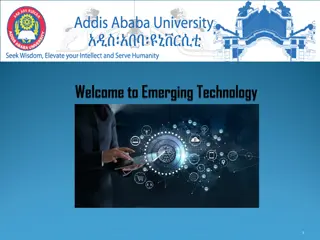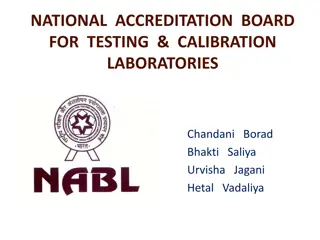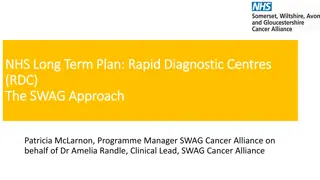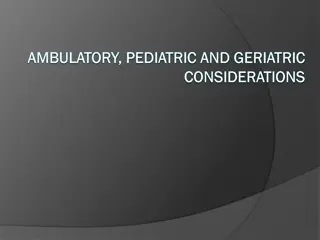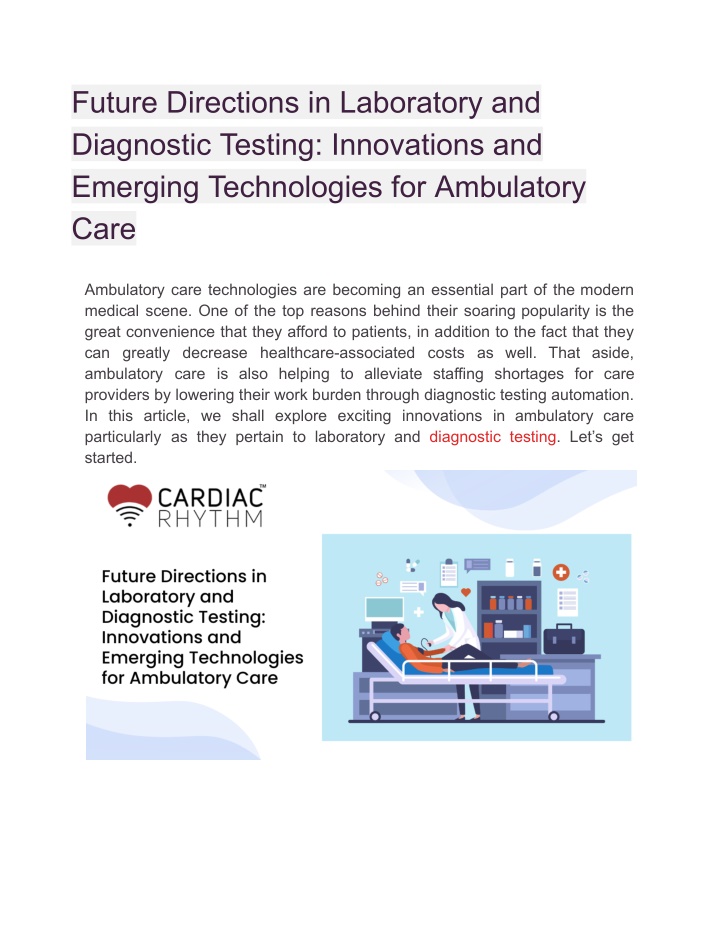
Future Directions in Laboratory and Diagnostic Testing_ Innovations and Emerging Technologies for Ambulatory Care
Ambulatory care technologies are becoming an essential part of the modern medical scene. One of the top reasons behind their soaring popularity is the great convenience that they afford to patients, in addition to the fact that they can greatly decrease healthcare-associated costs as well. That aside, ambulatory care is also helping to alleviate staffing shortages for care providers by lowering their work burden through diagnostic testing automation. In this article, we shall explore exciting innovations in ambulatory care particularly as they pertain to laboratory and diagnostic testing.
Download Presentation

Please find below an Image/Link to download the presentation.
The content on the website is provided AS IS for your information and personal use only. It may not be sold, licensed, or shared on other websites without obtaining consent from the author. If you encounter any issues during the download, it is possible that the publisher has removed the file from their server.
You are allowed to download the files provided on this website for personal or commercial use, subject to the condition that they are used lawfully. All files are the property of their respective owners.
The content on the website is provided AS IS for your information and personal use only. It may not be sold, licensed, or shared on other websites without obtaining consent from the author.
E N D
Presentation Transcript
Future Directions in Laboratory and Diagnostic Testing: Innovations and Emerging Technologies for Ambulatory Care Ambulatory care technologies are becoming an essential part of the modern medical scene. One of the top reasons behind their soaring popularity is the great convenience that they afford to patients, in addition to the fact that they can greatly decrease healthcare-associated costs as well. That aside, ambulatory care is also helping to alleviate staffing shortages for care providers by lowering their work burden through diagnostic testing automation. In this article, we shall explore exciting innovations in ambulatory care particularly as they pertain to laboratory and diagnostic testing. Let s get started.
Virtual consultations as the point of first contact Before the patient even sets foot in a laboratory or comes in for diagnostic testing, it s becoming the trend today that they ll first connect with their care providers virtually. Virtual consultations can occur via video conferencing technologies typically on smartphones, laptops, and other portal devices. During this initial encounter, the physician can look to: 1. Review the patient s medication history 2. Understand the patient s condition 3. Try to figure out potential causes 4. Recommend and plan laboratory procedures 5. Schedule an in-person examination (if necessary) Remote patient monitoring technologies for diagnostic reinforcement Typically, after consultations, the physician will seek to understand the patient s condition better, and for that, they need more data about the patient s vitals and other metrics. This is where remote patient monitoring technologies, ,like that which we offer here at Cardiac Rhythm, come into play. With wearable devices such as the Faros 180, for example, the physician can get round-the-clock information about the patient s heart condition. If they suspect an arrhythmia or some other heart-related problem, then they can move on to blood work and other laboratory procedures if the data is not conclusive.
Machine learning for treatment personalization Machine learning is a subset of AI, where intelligent models assess data and learn from it to be able to perform a desired goal autonomously. These algorithms are becoming crucial in the personalization of care, which can make a huge difference in healthcare today. So why is personalized treatment in ambulatory important? Patients have unique conditions and health factors. Difference in genetic makeup can mean the difference between success and failure when using the same treatment plan on two different patients with basically the same condition. It can help overcome the limitations of traditional medicine, which are typically generic and therefore not as effective. Advanced automation to help with lab work Many laboratories have overstretched workflows, with too many samples and documents to process. Laboratory automation systems have emerged to speed up diagnostic testing while reducing the work burden on technicians. Essentially, these laboratory automation systems are composed of multiple tools and technologies, some of which include 1. Machine vision 2. Conveyor systems 3. Robots Besides sample handling, these systems may have robots that can also handle tasks related to data analysis. This reduces human involvement and the risk of human error, allowing lab technologists to focus on other tasks.
Predictive analytics for proactive ambulatory care Oftentimes, our care models are reactive, waiting for patients to get sick before responding. Predictive analytics change this by using advanced data analytics to predict the likelihood that a patient, who is in perfectly good health now, can develop a health compliance in the near future. Some of the benefits of predictive analytics in proactive care include: 1. Reduced adverse health events 2. Lower cases of admissions and readmissions 3. Better healthcare personalization 4. Lower cost of healthcare Beyond anticipating the onset of disease, this technology can also predict the likelihood of a patient s no-show during appointments, among other events, which can help lab technicians and physicians schedule diagnostic testing better. Next-generation sequence (NGS) Genomics is nothing new but NGS is still in its infancy, however, it s providing a way for us to be able to detect gene mutations in the RNA and DNA sequence, long before they manifest as visible symptoms for the patient. Overall, next-generation sequencing typically has four steps, and they include the following in a nutshell 1. The technician can isolate and extract the nucleic acid 2. This is followed by prepping the sample for the sequencer 3. Clonal amplifications then come into play 4. Various bioinformatics are then leveraged for data analysis. Of course, there s a lot more meat to the process but this is just the general outline. The most important thing of note here, however, is that this type of genetic testing can become a game changer in personalized treatment and
can accelerate the diagnosis of various genetic disorders such as some types of heart disease. Digital wayfinding systems The patient in ambulatory care may need to physically check into the healthcare facility for routine lab work and other purposes. In critical cases, such as when a patient is bedridden, family members who are unfamiliar with the hospital s layout may need to do so on behalf of their relative. Digital wayfinding systems for hospitals are making this a breeze, presenting maps and navigation aids with GPS for real-time location guidance. Some of them even leverage augmented reality for more detailed and reliable wayfinding. Such a system can help patients or family members find the right departments across a large hospital layout and generally enable the user to navigate the healthcare facility very effortlessly. While it may seem like such a simple innovation, it can help improve accessibility and decrease the risk of healthcare-acquired infections by minimizing human interactions. The paradigm shift is in full effect Technology is providing new twists and turns to diagnostic and laboratory testing as we ve seen so far. From NGS that can help nip genetic disorders like certain types of cardiomyopathy in the bud to predictive analytics that can help predict the likelihood of disease without comprehensive lab work, it s clear that there are many exciting emerging technologies and innovations for ambulatory care that can help us save time, money and, more importantly, lives. Instead of just reading about them, it s important to take action. Partner with one of the world s leading ambulatory care assistants in Cardiac Rhythm today to take your workflow to the next evolution of care.



